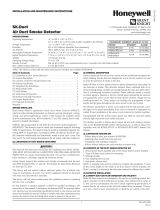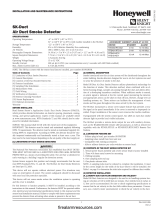
[5.4.3] Modifications Of Inlet Sampling Tubes
There may be applications where duct widths are not what
is specified for the installation. In such cases, it is permis-
sible to modify an inlet sampling tube that is longer than
necessary to span the duct width.
Use a 0.193˝ diameter (#11) drill and add the appropriate
number of holes so that the total number of holes exposed
to the air flow in the duct is 10 to 12. Space the additional
holes as evenly as possible over the length of the tube.
[5.5] Field Wiring Installation Guidelines
All wiring must be installed in compliance with the National
Electrical Code and the local codes having jurisdiction.
Proper wire gauges should be used. The conductors used
to connect smoke detectors to control panels and accessory
devices should be color-coded to reduce the likelihood of
wiring errors. Improper connections can prevent a system
from responding properly in the event of a fire.
For signal wiring, (the wiring between interconnected de-
tectors or from detectors to auxiliary devices), it is usu-
ally recommended that single-conductor wire be no smaller
than 18 gauge. The duct detector terminals accommodate
wire sizes up to 14 gauge. The last foot of conduit should
be flexible steel conduit (available in electrical supply
houses), which facilitates installation and puts less strain
on the conduit holes in the housing. Solid conduit connec-
tions may be used, if desired.
Smoke detectors and alarm system control panels have
specifications for allowable loop resistance. Consult the
control panel manufacturer’s specifications for the total
loop resistance allowed for the particular model control
panel being used before wiring the detector loop.
Wiring Instructions
The DH400ACDCP detectors are designed for easy wiring.
The housing provides a terminal strip with clamping plates.
Wiring connections are made by stripping about
3
/8˝ of in-
sulation from the end of the wire, sliding the bare end un-
der the plate, and tightening the clamping plate screw.
The DH400ACDCP duct detector is designed to operate
from 24 VDC, 24 VAC, 120 VAC, or 240 VAC.
The detector may be wired for interconnection to UL listed
control panels, or for stand alone service per NFPA 90A.
Refer to the wiring diagrams of Figures 7, 8, and 9 to select
the appropriate circuit for your application.
[5.6] Install The Filters
To install the sampling tube filters, simply push the filter
adapter into the exhaust tube, and push the filter onto the
adapter tube on the left, as shown in Figure 6. Install the
other filter over the end of the inlet sampling tube.
Figure 6. Sampling tube filter installation:
SAMPLING TUBE
FILTERS
SAMPLING TUBE
MOUNTING
SCREWS
DETECTOR HEAD
EXHAUST
FILTER ADAPTER
DETECTOR BASE
INLET SAMPLING TUBE
FOAM GASKET
H0532-00
Filters require periodic cleaning or replacement, depending
on the amount of dust and dirt accumulated. Visually in-
spect the filters at least quarterly; inspect them more often
if the dust accumulation warrants it. See Section [6] for
more information. Replacement filters can be ordered from
System Sensor, 3825 Ohio Ave., St. Charles, IL 60174. (Ex-
haust tube/intake tube filter P/N F36-05-00).
[5.7] Perform Detector Check
1. Perform the STANDBY AND TROUBLE TEST per Sec-
tion [6.2.1].
2. Perform the MAGNET TEST per Section [6.2.2.1]. The
RTS451 test of Section [6.2.2.2] may substitute for
this requirement.
3. Perform the AIR FLOW TEST per Section [6.1.1].
4. Perform the SMOKE RESPONSE TEST per Section [6.1.2].
5. Perform the SENSITIVITY TEST per Section [6.2.3].
6. Record all test results in the Detector Test Log at the
end of this manual.
[5.8] Install The Cover
Install the cover using the four screws that are fixed in the
housing cover. Be certain filters are installed as specified
in Section [5.6]. Make sure that the cover fits into the base
groove and that all gaskets are in their proper positions.
Tighten the four screws to 10 in-lbs.
[6] Duct Detector Maintenance And Test Procedures
Test and maintain duct detectors as recommended in NFPA
72. The tests contained in this manual were devised to as-
sist maintenance personnel in verification of proper de-
tector operation.
Before conducting these tests, notify the proper authorities
that the smoke detection system will be temporarily out of
service. Disable the zone or system under test to prevent
unwanted alarms.
After conducting these tests, record the appropriate infor-
mation in the Detector Test Log at the end of this manual.
D400-13-00 5 I56-0555-010R


















